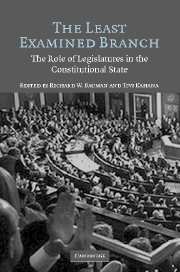13 results
New Ways of Looking at Old Institutions
-
-
- Book:
- The Least Examined Branch
- Published online:
- 06 August 2009
- Print publication:
- 31 July 2006, pp 1-14
-
- Chapter
- Export citation

The Least Examined Branch
- The Role of Legislatures in the Constitutional State
-
- Published online:
- 06 August 2009
- Print publication:
- 31 July 2006
Contents
-
- Book:
- The Least Examined Branch
- Published online:
- 06 August 2009
- Print publication:
- 31 July 2006, pp v-viii
-
- Chapter
- Export citation
PART FOUR - CONSTITUTION MAKING BY LEGISLATURES: THE IMPLICIT VERSION
-
-
- Book:
- The Least Examined Branch
- Published online:
- 06 August 2009
- Print publication:
- 31 July 2006, pp -
-
- Chapter
- Export citation
PART THREE - CONSTITUTION MAKING BY LEGISLATURES: THE EXPLICIT VERSION
-
-
- Book:
- The Least Examined Branch
- Published online:
- 06 August 2009
- Print publication:
- 31 July 2006, pp -
-
- Chapter
- Export citation
PART FIVE - CONSTITUTIONAL INTERPRETATION AND APPLICATION BY THE LEGISLATURE
-
-
- Book:
- The Least Examined Branch
- Published online:
- 06 August 2009
- Print publication:
- 31 July 2006, pp -
-
- Chapter
- Export citation
Contributors
-
- Book:
- The Least Examined Branch
- Published online:
- 06 August 2009
- Print publication:
- 31 July 2006, pp xv-xviii
-
- Chapter
- Export citation
PART SEVEN - THE LEGISLATURE IN DIALOGUE: DOMESTIC AND INTERNATIONAL CONTEXTS
-
-
- Book:
- The Least Examined Branch
- Published online:
- 06 August 2009
- Print publication:
- 31 July 2006, pp -
-
- Chapter
- Export citation
PART TWO - LEGISLATING AND DELIBERATING IN THE DEMOCRATIC LEGISLATURE
-
-
- Book:
- The Least Examined Branch
- Published online:
- 06 August 2009
- Print publication:
- 31 July 2006, pp -
-
- Chapter
- Export citation
PART ONE - LEGISLATURES AND DEMOCRATIC THEORY
-
-
- Book:
- The Least Examined Branch
- Published online:
- 06 August 2009
- Print publication:
- 31 July 2006, pp -
-
- Chapter
- Export citation
PART SIX - IS LEGISLATIVE CONSTITUTIONALISM POSSIBLE?
-
-
- Book:
- The Least Examined Branch
- Published online:
- 06 August 2009
- Print publication:
- 31 July 2006, pp -
-
- Chapter
- Export citation
Index
-
- Book:
- The Least Examined Branch
- Published online:
- 06 August 2009
- Print publication:
- 31 July 2006, pp 567-596
-
- Chapter
- Export citation
Frontmatter
-
- Book:
- The Least Examined Branch
- Published online:
- 06 August 2009
- Print publication:
- 31 July 2006, pp i-iv
-
- Chapter
- Export citation



